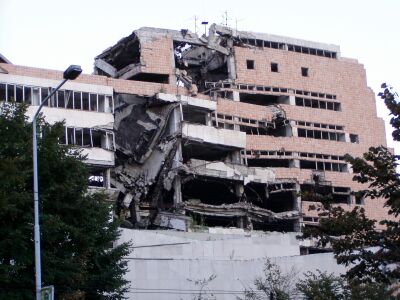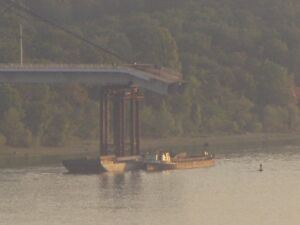History - a short overview
Some thousand years ago, the region around present-day Serbia was inhabited first by Illyrian, later on by Celtic tribes. The Roman Empire conquered the land already during the 3rd century BC and named it Moesia Superior. The river Danube marked the northern border of the province. In the year 395 AD, the Roman Empire split into two parts. Ever since, Serbia belonged to the Byzantine Empire, whereas present-day Croatia became a part of the West Roman Empire.
During the 6th century, first Slav tribes entered the region, namely Slovenes, Croats and Serbs. All of these tribes converted to Christianity around the year 895. This was mostly thanks to the two monks Cyril and Methodius. For the first time in history, an independent Serbian Kingdom was founded in the year 1217. During the reign of Stefan Dushan in the 14th century, Serbia experienced its heyday. At that time, many monasteries were built. Things changed dramatically after his death - Serb forces were defeated at the decisive battle of Косово Поље (Kosovo Polje, polje=field) by the Ottomans in the year 1389. Since then, Serbias was occupied by the Ottoman Empire for almost 500 years. The first large and partially successful uprising took place in the year 1815. Serbia became quasi-independent and was granted greater autonomy in 1829. However, it couldn't gain full independence before the year 1878.
In 1914, a young Serb assassinator killed Archduke Ferdinand in →Sarajevo. This event lit the powder keg. As a result of the assassination, the →Austro-Hungarian Monarchy annexed Serbia which marked the beginning of the First World War. After the end of the war and the defeat of the monarchy, →Slovenia, →Croatia and the Војводина (Vojvodina) united with Serbia, Montenegro and →Macedonia. The Kingdom of Slovenes, Croats and Serbs was eventually renamed Yugoslavia (Country of the Southern Slavs) in the year 1929.
In 1941, Yugoslavia first joined the fascist Berlin-Rome-Tōkyō axis, a decision that initiated a coup d'état). As a result of the coup, Peter II. became king and made a U-turn by leaving the axis. This of course caused Hitler to march in and occupy the country, just to share it between Germany, Italy, →Hungary and →Bulgaria. Almost immediately, the Communist Party led by Josip Broz Tito became active and declared armed resistance against the occupiers.
In 1945, after the end of World War II, the Communists finally took over and abolished the monarchy. Bosnia, Montenegro and Macedonia were granted the status of a republic inside the federation - Croatia, Slovenia and Serbia had this status already before the war. However, republican status was denied to Albanian-dominated Kosovo as well as to the Hungarian-dominated Vojvodina. The fact that these two regions hadn't had republican status before the war and never belonged to the 'old' Yugoslavia was used as the main reason for the denial. And so the Federal Republic of Yugoslavia, ie the 2nd Yugoslavia, was born. →Belgrade was declared capital of the federation.

| ||
| Traces of the NATO air raids |
In contradiction to most other countries within the Soviet sphere of interest, Tito broke almost all links with Stalin in the year 1948. This gained him financial and other sorts of aid from Western Europe and the United States. Things didn't change a lot until the 1980ies. Links to other communist countries were not very tight, too. To give an example, normal citizens of East Germany were not allowed to travel to Yugoslavia. However, the country, ie the Adriatic Sea coast, was highly popular with tourists from West Germany.
This fragile, artificial structure called Yugoslavia didn't last longer than until 1986. It was at the latest in that year, that the seal was set on the collapse of the federation. The Serbian Academy of Sciences commited intellectual arson by calling for greater Serb domination in Yugoslavia. In 1987, Slobodan Milošević became the head of the ruling Communist Party and started mixing the party statutes with Serbian nationalist ideas. This frightened the people of the other republics, and so →Slovenia and →Croatia declared independence. Further events came hot on the heels of the declaration. The Serb dominated JNA (Yugoslav National Army) annexed Slovenia. After a few minor fights during the so-called 10-days war, the JNA pulled out their troops, because there weren't any Serb claims on the country. In 1992, the EU recognized Slovenia and Croatia as independent countries and imposed an arms embargo on the rest of Yugoslavia (at least!).
Soon after, heavy fights erupted in Croatia over the so-called Krajina Serbs (for more information on the Krajina-Serbs see →History of Croatia). Inevitably, the now full-scale war between Croatia and Serbia was soon to expand into →Bosnia-Hercegovina. Bosnia tried to gain independence as well - and so did →Macedonia at the same time. The big difference was that Macedonia was only of marginal interest to Serbia. And so Macedonia was the one and only former Yugoslav republic that mamaged to get away without firing a single shot. In Bosnia-Hercegovina, the war was about to become particularly brutal. It developed into an ethnic conflict between all races and religions - both of them didn't play a big role before. →Sarajevo suffered a three-years siege, leaving an estimated 10,000 civilians dead. Serbia (as well as Croatia!) tried hard to gain as much control over Bosnian territory as possible. The UN, represented by the so-called UNPROFOR, was present but absolutely helpless. And so Serb militia could drag the Bosnian vice president out of an armoured vehicle just to shoot him in front of the UNPROFOR soldiers. Also, the UN was not able to prevent thousands of civilians from being slaughtered after the fall of Srebenica - actually one of the so-called UN protected areas. The incident is now known as the Srebenica massacre. The whole, awkward dilemma is well (not to say too well!) depicted by the British movie "Warriors".

| ||
| Bridge near Novi Sad: Primary target of NATO air raids |
The NATO intervened as late as 1994, sending in combat aircrafts. In 1995, all parties agreed on the Dayton Accord, which ended the war in Bosnia by dividing the country into two entities. Even today, KFOR troops remain in the country and Milosevic is committed for trial at the International War Criminal Tribunal. But this was only the end of the war over Bosnia. Serbia and Montenegro founded the Third Yugoslavia in 1992. Already years before, the autonomy status of →Kosovo (actually, the area is referred to as Косово и Метохија (Kosovo i Metochiya)) was suspended by the central government. Permanent provocations, often performed by JNA troops, ignited a civil war starting in 1998. Around 90% of the Kosovo citizens are Albanians. As in Bosnia, an ethnic cleansing campaign was launched, making hundred thousands of Albanians flee the region - some of them to Albania, others to →Macedonia. Occasional massacres of civilians were reported as well. Consequently, militant Albanians, eg UÇK fighters, entered Kosovo and tried to fight back. This time, the UN and the NATO reacted a little bit faster. After numerous fruitless measures such as protest notes, threats, a full-scale trade embargo etc, the war was taken to Serbia for the first time during the conflict. For a good reason (rough terrain etc), the NATO was afraid of a long and bloody conventional war, and so combat action was limited to massive air strikes. After 78 days of daily air raids, the Serbian government gave in. Despite the fact that the military campaign was a sad thing, it also produced the gag of the year, namely the accidental bombing of the Chinese embassy in Belgrade. On the grounds that the CIA doesn't possess recent city maps of Belgrade. Which is really hard to believe. Heaven forbid that the military intelligence of the US is really that stupid!
It's not quite clear how things will go on in Serbia. After the long overdue deposition of Milosevic things started to look much better. Democratic as well as economic reforms were initiated. However, the assassination of the prime minister Zoran Ðinđić in 2003 was quite a big shock and left many things open to question. Nevertheless, it's easy to believe that Serbia has developed into a normal, peaceful country when you walk around →Belgrade or →Novi Sad. But what's under the surface? How will things go on in Kosovo? What does the majority of Serbs think about the recent EU-friendly line of the government? I would like to believe that the bloody chapter called the Balkan conflict is over, but I'm afraid it isn't.
Update 2006: →Montenegro finally decided to leave the union as well. And the future of the →Kosovo as a part of Serbia is more uncertain then ever.
©2024 Europe-East.com

 Albania
Albania Serbia
Serbia